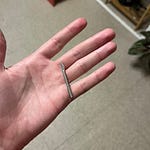I identify more strongly as a sadomasochist than as a lesbian. I hang out in the gay community because that’s where the sexual fringe starts to unravel. Most of my partners are women, but gender is not my boundary…If I had a choice between being shipwrecked on a desert island with a vanilla lesbian and a hot male masochist, I’d pick the boy. This is the kind of sex I like—sex that tests physical limits within a context of polarized roles.
If it seems like I quote Patrick Califia’s “A Secret Side of Lesbian Sexuality” in every other newsletter, well, can you blame me? Like Alex Chee on E. M. Forster, Kim TallBear on sex and family, Astra and Sunaura Taylor on animal liberation, or Patricia Lockwood on Vladimir Nabokov, Califia on desire is, for me, a long revelation. Each time I return to this essay, it revitalizes me, as the backs of shampoo bottles like to say. If I step away for a few years, I may even discover, upon my return, that a challenging concept has suddenly slid into focus.
When I read this passage for the first time, I was awestruck, but I also believed I understood it completely. Green as I was, I figured I followed its elucidation of the work of freedom, the intellectual effort required to define and then pursue one’s desires (Gender is not my boundary!) as, if not distinct from social mores and pressures, then at least plastic enough to be played with. (I also perceived within it the kernel of transsexual privilege, which is that we get to have sex with everyone we want to because we are more beautiful and special than normal people, but that’s besides today’s point.) Over the years, my body has grown into this knowledge: I grasp the work of this kind of freedom. I am doing it all the time.
But in thinking that I understood this passage completely, I was mistaken, as I learned when I returned to it recently and sensed something new there. For a long time now, I’ve trusted in desire as a route to freedom; or trusted that freedom can be found in the honest embrace of desire. This is because I owe my desire everything. When I was young, it brought me to gay people, who eventually brought me to my current political commitments, which are broader than gayness, and include the commitments of those coalitions of which I’m not a member. Desire need not always be fulfilled—in fact, I think it oughtn’t be—but it should always be acknowledged, if not explored.
Gender is not my boundary. In my first reading of this line, I understood it as an imperative of sorts: If there is a boundary, it must be crossed—and thus, annihilated. Very genderqueer, as the enbies of my generation called ourselves. With this perspective, connection happens in the wake of destruction: like vampires, in making more of those like ourselves, we eliminate those who are not. But what if, instead of destroying boundaries, you brought them along with you to that island?
At an event in London a few weeks ago, I had a wonderful conversation about my book, leathersex, and dyke drama with Christie Costello. She asked me to define leather, and I did my best before putting the question back to her. I won’t paraphrase her answer, but were I to centrifuge it, the juice would gather round the word excess. Excess of gender, excess of sex, excess of feeling and of affect.
I think of Christie’s excess when I think of my new reading of A Secret Side of Lesbian Sexuality. Califia’s hot male masochist is my straight person, or my gay man, and these are not exceptions to my being a dyke, but rather included by it, subsumed by it. I connect more with highly-gendered people than people with whom I, ostensibly, share genders. Which in the context of this reading means, to me, that I do not bring people unlike me to the island, but rather that have found new ways to experience our likeness. Our connection by way of extremity is our similarity.
Who would be on my island? Total tops and absolute bottoms of a variety of genders and sexualities. I don’t switch in scene, but between them, occupying alternately strict realities that remain, like gelatin molds, soft yet fast. For this reason, I can identify with straight people, even those who don’t know what topping and bottoming is, over gay people who don’t fuck that way, or who are switchy or vers, or otherwise less rigid in what it is they do. This diversity of connection needn’t be a hierarchy of values; there is no right way, just the way that I fuck. That is desire. This is the kind of sex I like—sex that tests physical limits within a context of polarized roles. (NB: “queer” and “bi” and concepts like those work just fine for lots of people, by the way!)
My connections with highly-gendered people, and with people whose sexual sensibilities are, like mine, structured, controlled, formalized, rigid, inflexible, and courtly, overlap, extending even to straight people (and always has, I suppose). Benighted straight people! Straight women who are unwilling to give up the hidden power of heterosexuality and straight men whose sense of straightness is unshakeable, or is different from the conventional understanding of straightness (trade as straight, a queered heterosexuality that is, nevertheless, straight)—I love that shit. I also hate it. But I do love it. At any rate, it’s complicated.
There was a popular meme, for a minute there, that non-binary people were sharing that said something to the effect of If you’re attracted to me, you’re gay. Which, if that’s your experience of yourself, sure, fine. But I’m much more interested in the challenges of maintaining what are, for most of us, deeply held understandings of our own genders and sexualities when they are fundamentally incompatible with those with whom we vibe and fuck. How can straight people and gay people have sex? It happens all the time! How can dykes fuck fags? Literally every day. How can one be a monogamous sex worker? Easily! How can your identity not invalidate mine when our bodies push against each other? I don’t know, but it can!
Find me on Twitter. Get my second novel, X, right here.













